How To Install Vlc In Pc
VLC is a free and open-source media player that supports a wide range of audio and video formats and encoding methods.
If you've been a VLC user on Mac or Windows and recently switched to Linux, or if yous've been using some other media histrion on your Linux machine and are interested in trying out VLC later hearing about all its goodness, the get-go step is to install VLC on your figurer.
Even so, since software installation on Linux tin be intimidating to some, here's a guide to simplify installing VLC Media Player on Linux.
VLC is supported by a number of Linux distros. And much similar any other software, there are unlike ways to install VLC on all of these different distros.
Using the default package manager happens to exist the virtually obvious choice for many Linux users. So depending on which Linux distro yous're using, follow the steps below accordingly to go VLC on your machine.
On Ubuntu or Debian-based distros, you can apply the APT packet manager to install VLC. For this, open up the terminal and run the following command:
sudo apt install vlc At any signal in the hereafter, if you wish to uninstall VLC, run:
sudo apt remove vlc To install VLC on Fedora/CentOS or whatsoever other RHEL-based distro, you'll have to first enable the Free and Non-complimentary RPM Fusion repositories.
sudo dnf install https://download1.rpmfusion.org/free/fedora/rpmfusion-free-release-$(rpm -E %fedora).noarch.rpm
sudo dnf install https://download1.rpmfusion.org/nonfree/fedora/rpmfusion-nonfree-release-$(rpm -East %fedora).noarch.rpm So, update your system's parcel list and install VLC equally follows:
sudo dnf update
sudo dnf install vlc When you want to uninstall VLC, you can practice so using:
sudo dnf remove vlc If y'all're using Arch Linux or Manjaro, both of them already contain the VLC package in their official repositories, so you tin install VLC by simply running this command:
sudo pacman -Due south vlc To uninstall it, run:
sudo pacman -R vlc You can install VLC on openSUSE using Zypper. But before that, yous'll accept to add the VLC repository:
sudo zypper ar http://download.videolan.org/pub/vlc/SuSE/<SUSE version> VLC Call back to supervene upon <SUSE version> in the control with the version you're running. Available options include Tumbleweed, Leap_15.0, and Leap_42.3.
Then, install the VLC package as follows:
sudo zypper mr -r VLC
sudo zypper in VLC To uninstall VLC media thespian, run:
sudo zypper rm VLC Install VLC Using a GUI-Based Software Manager
Most all Linux distros come with a GUI-based software managing director, like the Synaptic Package Managing director on Ubuntu, to aid with graphical software installation.
So if you're not a fan of the terminal, you lot can use the software director app on your organisation to install VLC. This guide volition listing steps for the Synaptic Package Manager but the steps are substantially the same for other apps.
To get started, open up the Applications menu and launch the software managing director available on your figurer. Then, click on the search box and lookup vlc.
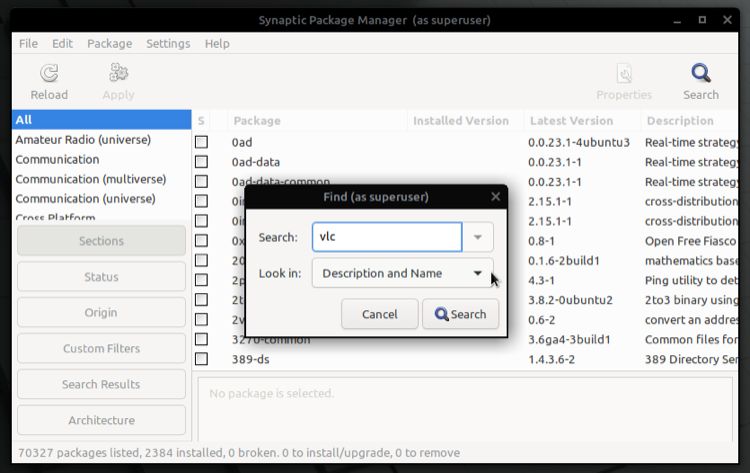
When it returns the result, tick the checkbox adjacent to vlc and select Mark for installation from the card options. If you want to install add together-ons for VLC, check off the boxes next to them to mark them for installation.
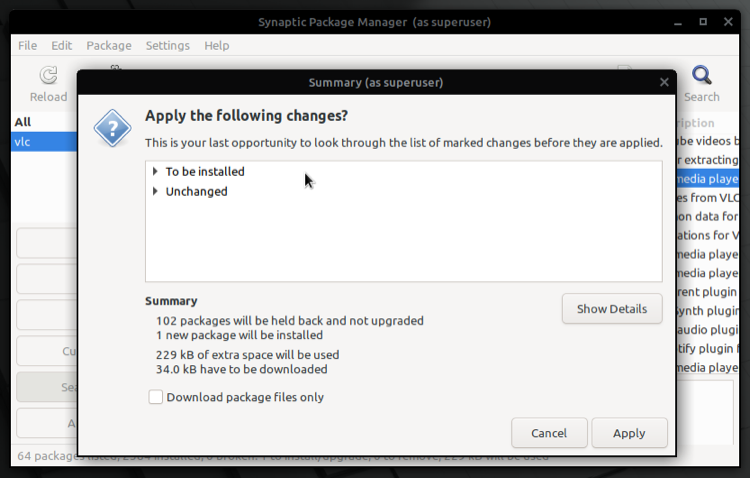
Finally, hit the Utilise push at the tiptop and hitting Apply once more to ostend all your marked changes.
Snap is a cantankerous-platform software packaging and deployment system adult by Canonical. Information technology's uniform with most major Linux distros, such as Debian, Ubuntu, Arch Linux, CentOS, Fedora, and Manjaro.
Using Snap is quite piece of cake, and it makes installing programs on Linux much easier than the traditional package manager method.
To install VLC from Snap Store, kickoff, make sure you have the snap package installed on your Linux machine. For this, open the terminal and run:
snap If this returns an error bulletin—something along the lines of 'snap not institute'—it means Snap isn't available on your system, and you demand to install Snap first. Follow our detailed guide on Snap to learn how to practice this.
With Snap installed, enter the following command to install VLC:
sudo snap install vlc In case you wish to remove information technology in the future, run:
sudo snap remove vlc Similar to Snap, Flatpak is another universal packaging system used for edifice, distributing, and running sandboxed apps on Linux. It, too, comes in handy when it'due south difficult to find packages for programs on certain Linux distros.
To install VLC Media Player using Flatpak, information technology'southward important to have Flatpak installed on your computer. You can verify if your organisation has it by running:
flatpak If you get an mistake bulletin, information technology goes on to show that Flatpak isn't present on your device. In this case, follow our consummate guide on installing and using Flatpak.
Once Flatpak is installed and running, run the post-obit command to install VLC:
flatpak install flathub org.videolan.VLC If yous'd like to remove VLC downward the road, run:
flatpak uninstall org.videolan.VLC Once VLC is successfully installed on your computer, here are the steps to get it running.
Showtime, open the Applications bill of fare and fire up VLC Media Histrion. Alternatively, y'all tin open the concluding and run the vlc control to start the program. This volition, however, crave you lot to have the terminal window open in the background while the app is running.
VLC will now prompt you with a Privacy and Network Access Policy window. Uncheck the Allow metadata network access selection in this prompt to avert giving away whatsoever metadata to the app, and so striking Continue.
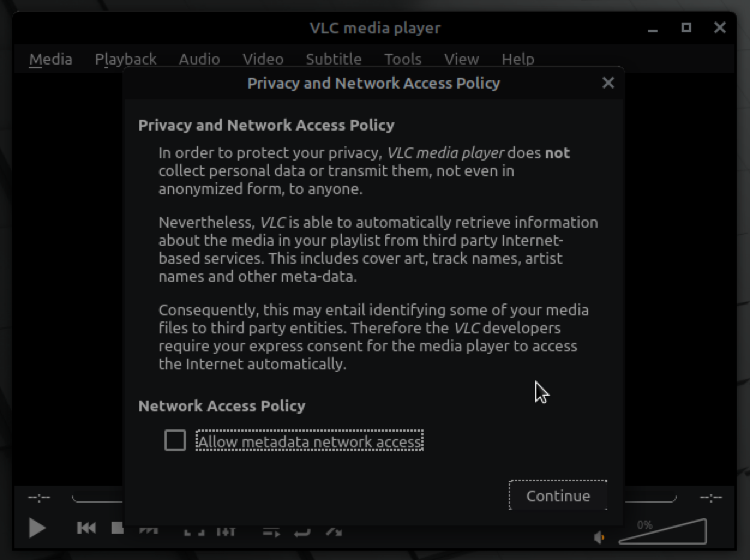
At present, you tin can play any media file on your computer or online in VLC. Non just that, yous can also record your screen with VLC. Check out what else you can do with the program in our VLC features guide.
If yous'd similar to modify VLC'southward settings, become to Tools > Preferences. Here, click on the All radio push button nether Show settings to reveal all the settings for VLC, including the avant-garde ones like syslog, codecs, demuxers, filters, etc.
In instance you aren't very familiar with VLC, here are a few features you lot must use on your system.
1. Audio Normalization
Audio normalization is i of the best VLC features. Information technology lets you set a constant volume level for all media you stream in VLC to protect your ears from sudden, sharp loud noises.
To use it, head over to Tools > Preferences > Audio. Here, tick the checkbox next to Normalize Volume and set its value.
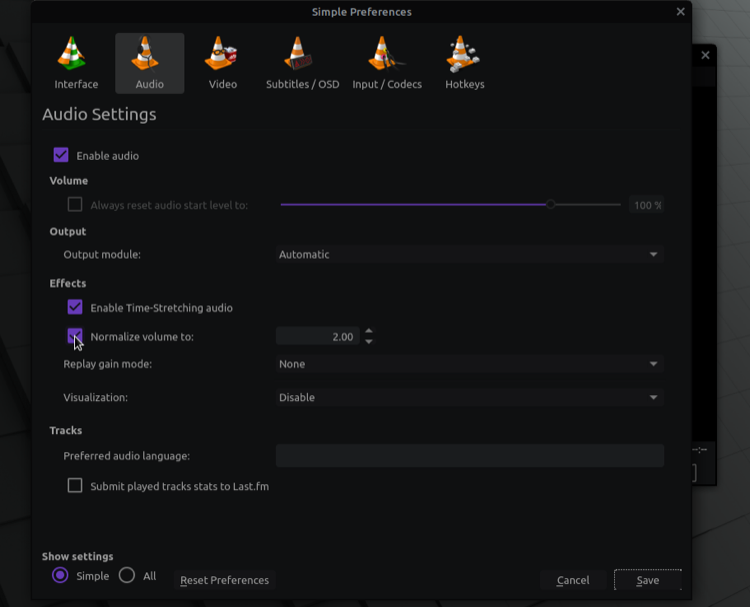
2. VLC Add-Ons
While VLC should suffice the needs of about individuals in its default state, for those who desire to go more than out of the role player, there are add-ons.
Simply put, VLC add-ons are all sorts of programs, like extensions, skins, and playlist parsers, among others, which aid you lot extend VLC'south functionality.
For example, you lot tin can utilise the VLSub VLC extension to download subtitles for movies from OpenSubtitles and play them along while watching movies.
To access VLC add-ons, go to Tools > Plugins and extensions, and search for an extension using the search box.
3. VLC Custom Skins
VLC supports customization using themes. So if you're bored with the basic interface and theme of the histrion, you can download a new skin from the VLC skin website and use it on your organization.
For this, after you've downloaded a theme, become to Tools > Preferences and select the Apply custom skin radio push button. Then, choose the skin you lot've downloaded to apply information technology.
4. VLC Interface Customization
Besides using custom skins, VLC also lets yous customize the interface past modifying the position of the toolbar buttons. To do this, click Tools > Customize Interface. From here, you can select the toolbar items yous want to modify and choose from the different options available for it to customize its advent to your liking.
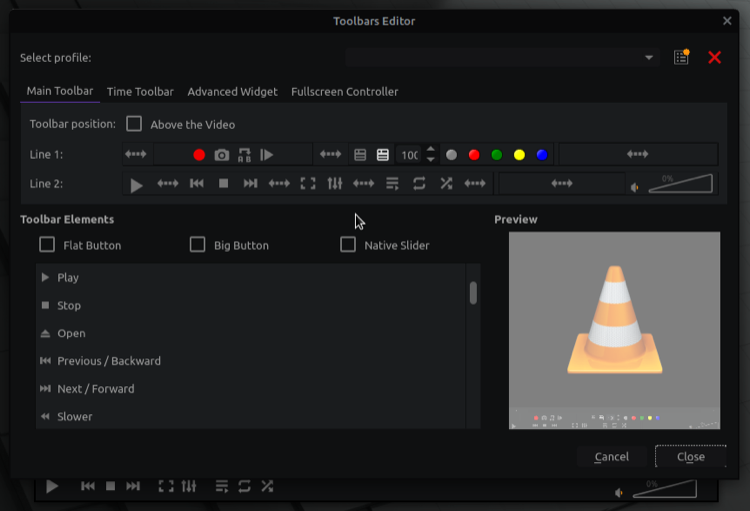
5. Master Keyboard Shortcuts
VLC, just like whatsoever other program, includes a slew of keyboard shortcuts to assist yous perform operations speedily and efficiently. You lot can check out these shortcuts by going to Tools > Preferences and selecting Hotkeys from the pinnacle.
Moreover, yous can besides change keyboard shortcuts for a lot of these functions to your preference if required.
If y'all followed this guide closely, y'all should have VLC Media Player up and running on your Linux car. And subsequently, yous should be able to view simply about any media y'all'd like to.
Not merely that, you can also do a wide range of other things with VLC. For instance, you tin record the screen, catechumen file formats, trim videos, stream to Chromecast, and rip DVDs with VLC, in addition to several other operations.
Besides, if you aren't happy with what VLC offers, or if it seems too complicated, you can check out some other media players for Linux.
Virtually The Writer
Source: https://www.makeuseof.com/install-vlc-media-player-linux/
Posted by: foxandef1993.blogspot.com



0 Response to "How To Install Vlc In Pc"
Post a Comment